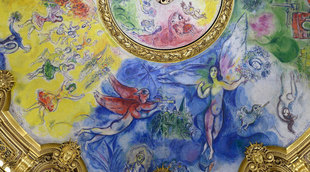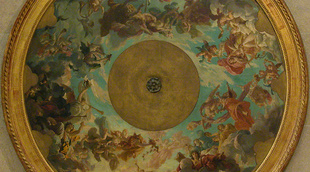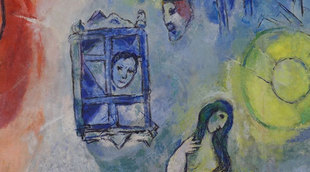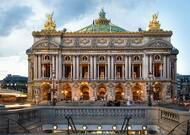 © DR
© DR
On the 23rd of September 1964, exactly 50 years ago, the French Ministry of cultural affairs André Malraux was inaugurating the new Palais Garnier opera house’s ceiling, made by Marc Chagall – and hiding the original ceiling of the Parisian edifice created by Jules Lenepveu. This work didn’t leave indifferent and aroused strong polemics still vivid nowadays. This anniversary gives us the opportunity to revisit the passionate history of the Garnier Opera’s ceiling.

In 1860, Napoleon the third ordered the construction of an imperial Academy of music and dance in the heart of Paris. The creator of the building that would become Paris opera house would be chosen after an anonymous contest whose, unexpectedly, is won by the young Charles Garnier (unknown and who hasn’t built anything yet) right under the noses of the renowned builders of the second Empire. Charles Garnier, who will give his name to the Parisian opera, imagines then a building mixing different styles and inspirations in order to design a temple dedicated to arts looking like a theatre set, at the same time sumptuous and modernist in its conception.
The avant-gardism sometimes discussed, even criticized, has marked this place all along its history and especially on the 23rd of September 1964, exactly fifty years ago, for the inauguration of the main auditorium’s ceiling made by Marc Chagall – ceiling covering over 240 m² hiding the original one designed in the 19th century by the painter Jules Lenepveu whose we are celebrating the anniversary today.
On the 17th of February 1960, General de Gaulle and André Malraux, then Ministry of cultural affairs, welcome an official Peruvian delegation and attend the premiere of Daphnis and Chloe, the ballet that Maurice Ravel performed at the Palais Garnier opera house with both the set and the costumes designed by Marc Chagall. The history says that, not much interested in what was going on on the stage, the minister raised his eyes on the ceiling and discovered the very academic work of Jules Lenepveu. During the intermission, André Malraux asks Marc Chagall (whom he admires for a long time and has known for thirty years) to design a new ceiling. Chagall, suspicious about orders, makes sketches and models before finally accepting (voluntarily) this challenge, both because of his friendship for André Malraux and to pay tribute to the great composers who brings life to the Palais Garnier opera house.

This order becomes official in 1962… and quickly arises a breaker of criticisms in the newspapers. One stigmatizes the “artificial modernity” and the anachronistic features of this reinvention of the opera ceiling. One says that the original Lenepveu’s version (The Muses and the Hours of the day and night, a spectacular and mythological representation of Art showing the muses inspiring the authors) fits perfectly in the setting and in the architecture of the building without distracting the audience from the performances on stage.
Chagall’s work must nevertheless bring a fresh impetus to the opera – judged old-fashion and dusty, needing to be shaken up. Chagall’s ceiling takes then a very political dimension: Malraux lays the foundations of what a minister of cultural affairs’ role should be and considers art as a way to contribute to the international French standing. But at that time the Palais Garnier costs a lot of money and is the center of some social contestations, and Chagall’s ceiling becomes the symbol of the lyrical politic of the minister, despite of the risk to hurt certain conservative ideas.
Facing criticisms, Malraux holds on but agrees on a few concessions: the original ceiling by Lenepveu will be preserved and Chagall’s work will be made on a 240m² removable canvas stretched above it. Nevertheless, the virulence of some attacks forces the painter to produce his work in secret, in a workshop of the Gobelins neighborhood, before being assembled in Meudon under military protection.

On the 23rd of September 1964, the work of the Belarusian painter is inaugurated in the Palais’ auditorium, unveiling twelve panels and a central circular panel mounted on the canvas. Chagall pays tribute to the great names of Music by showing fourteen composers from all periods, alluding to opera and ballet in a torrent of already “surrealistic” colors, but also the emblematic monuments of the Capital (the Eiffel Tower, the Concord) and its major musical places (the Palais Garnier itself), or even André Malraux in person who can be glimpsed behind a window. Chagall’s ceiling aims to be an “allegoric circulation”, a representation of “dreams and creations of actors and musicians”. Nowadays, Chagall’s ceiling is still in the center of a quarrel opposing modern and classic, but one must note that beyond the artistic considerations, the (political) aim of Malraux to put the Palais Garnier back in the center of the news is definitely reached.
the 23 of September, 2014 | Print



Comments